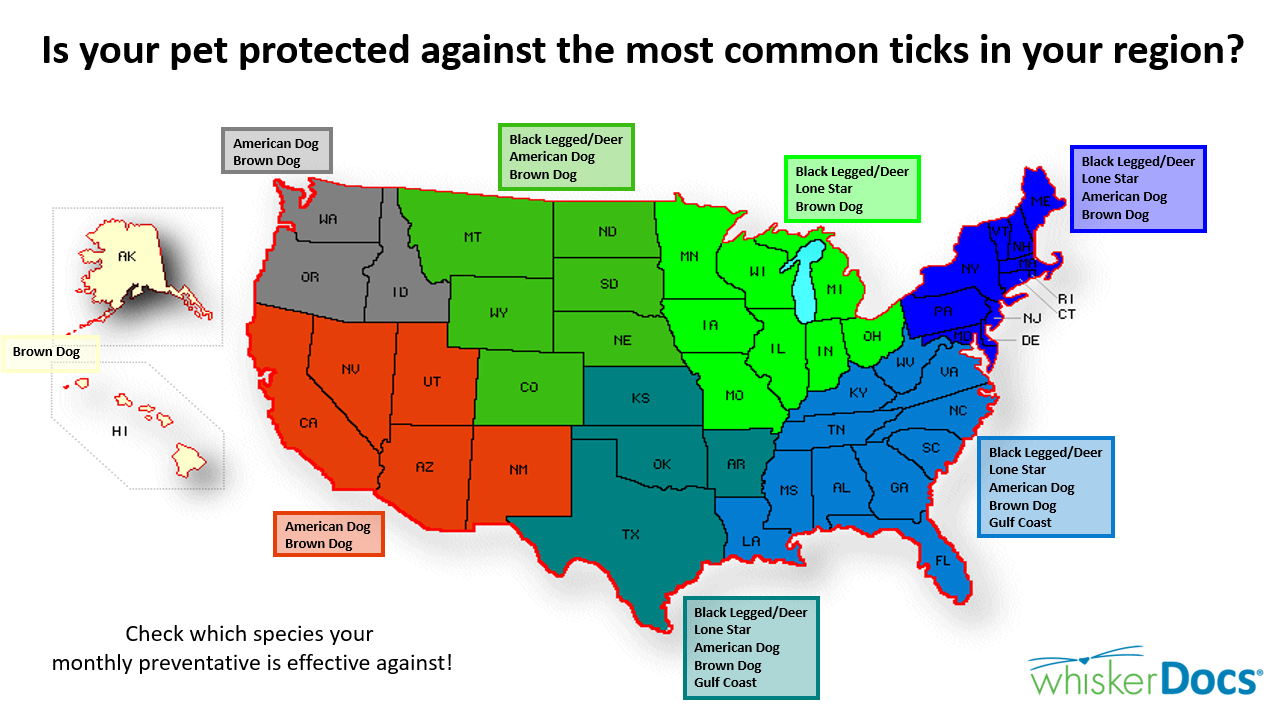Tick Information
How did my pet get bitten by a tick even though I use a preventative?

Unfortunately, no flea or tick preventative is ever 100% effective. That said, it's actually more likely that you're using a preventative that doesn't provide adequate protection for your geographical region.
Surprised? Have a look at the map above to see the types of ticks in your area. You might be surprised to learn that your monthly preventative is only protecting against a couple of species of ticks, and doesn't have coverage for the others!
How do I make sure I'm using the correct tick protection for my pet?
Below is a table of some of the most common flea, tick, and heartworm preventatives on the market. Please note that this is not an all-inclusive list.
| Product | Tick Types | Dog/Cat | Form |
| Selamectin (Revolution) | American Dog Tick | Both | Topical |
| Nexguard |
American Dog Tick Black Legged/Deer Tick Brown Dog Tick Lone Star Tick |
Dogs | Oral |
| Bravecto |
American Dog Tick Black Legged/Deer Tick Brown Dog Tick Lone Star Tick |
Both |
Oral (dogs) Topical (cats) |
| Activyl Tick Plus |
Brown Dog Tick Black Legged/Deer Tick |
Dogs | Topical |
| Vectra 3D |
American Dog Tick Black Legged/Deer Tick Brown Dog Tick Lone Star Tick Gulf Coast Tick |
Dogs | Topical |
| Simparica |
American Dog Tick Black Legged/Deer Tick Brown Dog Tick Lone Star Tick Gulf Coast Tick |
Dogs | Topical |
| Seresto Collar |
American Dog Tick Black Legged/Deer Tick Brown Dog Tick Lone Star Tick |
Both | Collar |
| Preventic Collar |
American Dog Tick Black Legged/Deer Tick Brown Dog Tick Lone Star Tick |
Dogs | Collar |
| Frontline Plus |
American Dog Tick Black Legged/Deer Tick Brown Dog Tick Lone Star Tick |
Both | Topical |
| Frontline Gold |
American Dog Tick Black Legged/Deer Tick Brown Dog Tick Lone Star Tick |
Both | Topical |
| Advantix II |
American Dog Tick Black Legged/Deer Tick Brown Dog Tick Lone Star Tick |
Dogs | Topical |
Could my pet get sick from a tick bite?
Depending on the species, ticks are known carriers of 16 different pathogens, each of which could make you or your pet ill. The most common afflictions are Lyme disease and Bobcat Fever, but there are others as well. It's important to make sure you're using the correct tick preventative for your pet's lifestyle and your geographical location so you can signifcantly reduce the risk of your pet's exposure to these illnesses.
How do I safely remove a tick?
Gently tweeze the tick from as close to the skin as possible. Be careful not to twist the tick, as this could leave parts of the mouth attached to your pet. Also, take care to avoid squeezing the engorged part of the tick, as doing so could cause the blood to return to your pet's bloodstream and increase the risk of infection of any pathogenic diseases that tick may have been carrying.
Do not use alcohol or vaseline to try to remove the tick. If possible, save the tick in a glass jar for identification in the event your pet does become sick after a tick bite!

